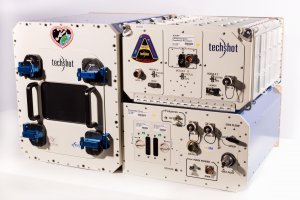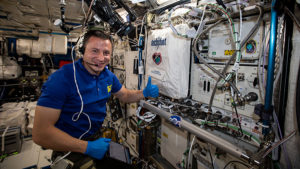Scientific discoveries and research missions beyond Earth’s surface are quickly moving forward. Advancements in the fields of research, space medicine, life, and physical sciences, are taking advantage of the effects of microgravity to find solutions to some big problems here on Earth. Researchers in 3D printing and bioprinting have taken advantage of space facilities that are dedicated to conducting multiple experiments in orbit, such as investigating microgravity’s effects on the growth of three-dimensional, human-like tissues, creating high-quality protein crystals that will help scientists develop more effective drugs, and even growing meat with 3D printing technology.
On November 2, 2019, a Northrop Grumman Antares rocket successfully launched a Cygnus cargo spacecraft on a mission to the International Space Station (ISS). The payload aboard the Cygnus included supplies for the 3D BioFabrication Facility (BFF), like human cells and bioinks, as well as new 3D printed ceramic fluid manifolds that replaced the previously used ones that were printed out of polymers. According to Lithoz – the company behind the 3D printed ceramic fluid manifolds – they are enabling advancements in bioprinting at the ISS.
The additive manufactured ceramics have been in service since November 2019 and Lithoz claims they have proven to provide better biocompatibility than printed polymers, resulting in larger viable structures.
 Lithoz, a company specializing in the development and production of materials and AM systems for 3D printing of bone replacements and high-performance ceramics, printed the ceramic manifolds using lithography-based ceramic manufacturing (LCM) on a high-resolution CeraFab printer in collaboration with Techshot, one of the companies behind the development of the BFF. Moreover, the ceramic fluid manifolds are used inside bioreactors to provide nutrients to living materials in space by the BFF.
Lithoz, a company specializing in the development and production of materials and AM systems for 3D printing of bone replacements and high-performance ceramics, printed the ceramic manifolds using lithography-based ceramic manufacturing (LCM) on a high-resolution CeraFab printer in collaboration with Techshot, one of the companies behind the development of the BFF. Moreover, the ceramic fluid manifolds are used inside bioreactors to provide nutrients to living materials in space by the BFF.
Testing of the ceramic 3D printed manifolds is focusing on biocompatibility, precision, durability, and overall fluid flow properties; and the latest round of microgravity bioprinting in December yielded larger biological constructs than the first BFF attempts in July.
Techshot and Lithoz engineers and scientists worked together to optimize the design and the manufacturing processes required to make it. Techshot Senior Scientist Carlos Chang reported that “it’s been an absolute pleasure working with Lithoz.”
Lithoz Vice President Shawn Allan suggested that “their expertise in ceramic processing really made these parts happen. The success of ceramic additive manufacturing depends on working together with design, materials, and printing. Design for ceramic additive manufacturing principles was used along with print parameter control to achieve Techshot’s complex fluid-handling design with the confidence needed to use the components on ISS.”
Headquartered in Vienna, Austria, and founded in 2011, Lithoz offers applications and material development to its customers in cooperation with renowned research institutes all over the world, benefiting from a variety of materials ranging from alumina, zirconia, silicon nitride, silica-based for casting-core applications through medical-grade bioceramics.
This work, in particular, highlighted an ideal use case for ceramic additive manufacturing to enable the production of a special compact device that could not be produced without additive manufacturing while enabling a level of bio-compatibility and strength not achievable with printable polymers. Lithoz reported that Techshot engineers were able to interface the larger bio-structures with the Lithoz-printed ceramic manifolds and that the next steps will focus on optimized integration of these components and longer culturing of the printed biological materials. While conditioned human tissues from this mission are expected to return to Earth in early 2020 for evaluation.
Back in July 2019, Gene Boland, chief scientist at Techshot, and Ken Church, chief executive officer at nScrypt, discussed the BFF at NASA’s Kennedy Space Center in Port Canaveral, Florida, how they planned to use the BFF in orbit to print cells (extracellular matrices), grow them and have them mature enough so that when they return to Earth researchers can encounter a close to full cardiac strength. Church described how a tissue of this size has never been grown here on Earth, let alone in microgravity. The 3D BFF is the first-ever 3D printer capable of manufacturing human tissue in the microgravity condition of space. Utilizing adult human cells (such as pluripotent or stem cells), the BFF can create viable tissue in space through a technology that enables it to precisely place and build ultra-fine layers of bioink – layers that may be several times smaller than the width of a human hair – involving the smallest print nozzles in existence.
Experts suggest that bioprinting without gravity eliminates the risk of collapse, enabling organs to grow without the need for scaffolds, offering a great alternative to some of the biggest medical challenges, like supplying bioprinted organs, providing a solution to the shortage of organs.
With NASA becoming more committed to stimulating the economy in low-Earth orbit (LEO), as well as opening up the ISS research lab to scientific investigations and experiments, we can expect to learn more about some of the most interesting discoveries that could take place 220 miles above Earth. There are already quite a few bioprinting experiments taking place on the ISS, including Allevi and Made In Space’s existing Additive Manufacturing Facility on the ISS, the ZeroG bio-extruder which allow scientists on the Allevi platform to simultaneously run experiments both on the ground and in space to observe biological differences that occur with and without gravity, and CELLINK‘s collaboration with Made In Space to identify 3D bioprinting development opportunities for the ISS as well as for future off-world platforms. All of these approaches are expected to have an impact on the future of medicine on Earth.
Subscribe to Our Email Newsletter
Stay up-to-date on all the latest news from the 3D printing industry and receive information and offers from third party vendors.
You May Also Like
3D Printing Webinar and Event Roundup: April 28, 2024
In this week’s 3D Printing Webinar and Event Roundup, the Ceramics Expo is taking place in Michigan, Stratasys continues its advanced training courses, and SPE is holding a Polymer Characterization...
Initial Speakers and Sponsors Announced for Additive Manufacturing Strategies 2025
Nearly a year away from the event, the Additive Manufacturing Strategies (AMS) 2025 conference is already beginning to take shape. Building upon the success of 2024’s summit, AMS has established...
HP & INDO-MIM Collaborate to Boost Metal 3D Printing in India
HP Inc. and INDO-MIM, a US- and India-based supplier of metal injection molding (MIM) powders and contract manufacturer, have announced that the two companies will collaborate to accelerate additive manufacturing...
One of US’s Largest Machine Tool Resellers to Offer Stratasys 3D Printing
In a key move for the additive manufacturing (AM) stalwart, Stratasys (Nasdaq: SSYS) has announced a strategic partnership with Select Additive Technologies, a division of Morris Group, Inc., which is...



































